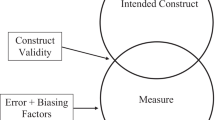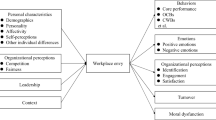Abstract
Contrary to extensive empirical tests of Agnew’s (Criminology, 30, 47–87, 1992) general strain theory (GST), little research has been applied to explaining organizational behaviors. Employing data from South Korean police officers, this study examined the relationship between police officers’ occupational strain and their turnover intention. More specifically, the current study investigated the mediating effects of negative emotions on the relationship between occupational strain and intention to resign, as well as the buffering effects of social support on the pathways linking strain, negative emotions, and turnover intention. Overall, the findings indicated that GST’s core propositions can be applied to a police occupational setting. Two of the three types of negative emotions had significant mediating effects on the linkage between strain and turnover intention as a non-deviant coping behavior. Furthermore, the results also provided partial support for the moderating role of social support, as GST posited. Theoretical and policy implication are also discussed.
Similar content being viewed by others
References
Agnew, R. (1992). Foundation for a general strain theory of crime and delinquency. Criminology, 30, 47–87.
Agnew, R. (2006). Pressured into crime: An overview of general strain theory. Los Angeles: Roxbury Publishing Company.
Aseltine, R. H., Jr., Gore, S., & Gordon, J. (2000). Life stress, anger, and anxiety, and delinquency: an empirical test of general strain theory. Journal of Health and Social Behavior, 41, 256–275.
Bayley, D. H. (1985). Patterns of policing: A comparative international analysis. New Brunswick: Rutgers University Press.
Brezina, T. (1998). Adolescent maltreatment and delinquency: the question of intervening processes. Journal of Research in Crime and Delinquency, 35, 71–99.
Broidy, L. M. (2001). A test of general strain theory. Criminology, 39, 9–33.
Broidy, L., & Agnew, R. (1997). Gender and crime: a general strain theory perspective. Journal of Research in Crime and Delinquency, 34, 275–306.
Capowich, G. E., Mazerolle, P., & Piquero, A. (2001). General strain theory, situational anger, and social networks: an assessment of conditioning influences. Journal of Criminal Justice, 29, 445–461.
Cheung, C., & Kwok, S. (1998). Social studies and ideological beliefs in mainland China and Hong Kong. Social Psychology of Education, 2, 217–236.
Corsianos, M. (2003). Discretion in detectives’ decision making and ‘high profile’ cases. Police Practice and Research, 4(3), 301–314.
Cortina, J. M., Doherty, M. L., Schmitt, N., Kaufman, G., & Smith, R. G. (1992). The “big five” personality factors in the IPA and MMPI: predictors of police performance. Personnel Psychology, 45, 119–140.
Cullen, F. T., Lemming, T., Link, B. G., & Wozniak, J. F. (1985). The impact of social supports on police stress. Criminology, 23, 503–522.
Dalessio, A., Silverman, W., & Schuck, J. (1986). Paths to turnover: a re-analysis and review of existing data on the Mobley, Horner, and Hollingsworth’s turnover model. Human Relations, 39, 245–264.
Drew, J., Carless, S. A., & Thompson, B. M. (2008). Predicting turnover of police officers using the sixteen personality factor questionnaire. Journal of Criminal Justice, 36, 326–331.
Gibson, C. L., Swatt, M. L., & Jolicoeur, J. (2001). Assessing the generality of general strain theory: the relationship among occupational stress experienced by male police officers and domestic forms of violence. Journal of Crime and Justice, 24, 29–57.
Hair, J. F., Black, W. C., Babin, B. J., Anderson, R. E., & Tatham, R. L. (2005). Multivariate data analysis (6th ed.). Upper Saddle River: Pearson.
Harris, L. M., & Baldwin, J. N. (1999). Voluntary turnover of field operations officers: a test of confluency theory. Journal of Criminal Justice, 27, 483–493.
Hickman, M. J., Piquero, A. R., & Greene, J. R. (2000). Discretion and gender disproportionality in police disciplinary systems. Policing: An International Journal of Police Strategies & Management, 23, 105–116.
Hoffman, V. (1982). The development of modern police agencies in the Republic of Korea and Japan: a paradox. Police Studies, 5, 3–16.
Horton, R., Rice, S. K., Piquero, N. L., & Piquero, A. R. (2012). On the variability of anger cross-culturally: an assessment of general strain theory’s primary mediator. Deviant Behavior, 33, 260–281.
House, J. S. (1981). Work stress and social support. Reading: Addison-Wesley.
Hunter, A. J. (1985). Private, parochial, and public social orders: The problem of crime and incivility in urban communities. In G. Suttles & M. N. Zald (Eds.), The challenge of social control: Citizenship and institution building in modern society (pp. 230–242). Norwood: Alex Publishing.
Ivkovic, S. K., & Kang, W. (2012). Police integrity in South Korea. Policing: An International Journal of Police Strategies & Management, 35, 76–103.
James, S., & Hendry, B. (1991). The money or the job: the decision to leave policing. Australian and New Zealand Journal of Criminology, 24, 169–189.
Jang, S. J. (2007). Gender differences in strain, negative emotions, and coping behaviors: a general strain theory approach. Justice Quarterly, 24, 523–553.
Jang, S. J., & Johnson, B. R. (2003). Strain, negative emotions, and deviant coping among African Americans: a test of general strain theory. Journal of Quantitative Criminology, 19, 79–105.
Jang, S. J., & Johnson, B. R. (2005). Gender, religiosity, and reactions to strain among African Americans. Sociological Quarterly, 46, 323–357.
Jang, S. J., & Lyons, J. A. (2006). Strain, social support, and retreatism among African Americans. Journal of Black Studies, 37, 251–274.
Jaramillo, F., Nixon, R., & Sams, D. (2005). The effect of law enforcement stress on organizational commitment. Policing: An International Journal of Police Strategies & Management, 28, 321–336.
Jones, D., Jones, L., & Prenzler, T. (2005). Tertiary education, commitment, and turnover in police work. Police Practice and Research, 6, 49–63.
Lambert, E. G. (2007). A test of a turnover intent model: The issue of correctional staff satisfaction and commitment. In D. E. Duffee & E. R. Maguire (Eds.), Criminal justice theory (pp. 223–255). New York: Taylor & Francis Group, LLC.
Laub, J. H., Nagin, D. S., & Sampson, R. J. (1998). Trajectories of change in criminal offending: good marriages and the desistance process. American Sociological Review, 63, 225–238.
Mazerolle, P., & Maahs, J. (2000). General strain and delinquency: an alternative examination of conditioning influences. Justice Quarterly, 17, 753–778.
Mazerolle, P., & Piquero, A. (1998). Linking exposure to strain with anger: an investigation of deviant adaptations. Journal of Criminal Justice, 26, 195–211.
Mazerolle, P., Burton, V. S., Cullen, F. T., Evans, T. D., & Payne, G. L. (2000). Strain, anger, and delinquent adaptations specifying general strain theory. Journal of Criminal Justice, 28, 89–101.
Moon, B. (2003). The politicization of police in South Korea: a critical review. Policing: An International Journal of Police Strategies & Management, 27, 128–136.
Moon, B., & Hwang, E. (2004). The reasons for choosing a career in policing among South Korean police cadets. Journal of Criminal Justice, 32, 223–229.
Moon, B., & Jonson, C. L. (2012). The influence of occupational strain on organizational commitment among police: a general strain theory approach. Journal of Criminal Justice, 40, 249–258.
Moon, B., Hwang, H., & McCluskey, J. D. (2011). Causes and school bullying: empirical test of a general strain theory of crime, differential association theory, and general strain theory. Crime & Delinquency, 57, 849–877.
Morash, M., Lee, C., Hoffman, V., Cho, S. H., & Haarr, R. (2006). Predictors of social and defensive coping to address workplace stressors: a comparison of police in South Korea and the United States. International Journal of Comparative and Applied Criminal Justice, 30, 149–176.
Nalla, M. K., & Kang, W. (2012). Organizational climate, perceived citizen support, and job satisfaction of police officers: findings from the post-grand reform era in South Korea. Asian Criminology, 7, 153–171.
Ngo, F. T., & Paternoster, R. (2013). Stalking, gender, and coping strategies: a partial test of Broidy and Agnew’s gender/general strain theory hypotheses. Victims & Offenders, 8, 94–117.
Paternoster, R., & Mazerolle, P. (1994). General strain theory: a replication and extension. Journal of Research in Crime and Delinquency, 31, 235–263.
Paternoster, R., Mazerolle, P., & Piquero, A. (1998). Using the correct statistical test for the equality of regression coefficients. Criminology, 36, 859–866.
Pino, N. W., & Wiatrowski, M. D. (2006). The principles of democratic policing. In N. Pino & M. D. Watrowski (Eds.), Democratic policing in transactional and developing countries (pp. 43–97).
Piquero, N. L. (2005). Understanding police stress and coping resources across gender: A look toward general strain theory. In H. Copes (Ed.), Policing and stress (pp. 126–139). Upper Saddle River: Prentice Hall.
Piquero, N. L., & Sealock, M. D. (2000). Generalizing general strain theory: an examination of an offending population. Justice Quarterly, 17, 449–484.
Piquero, N. L., & Sealock, M. D. (2004). Gender and general strain theory: a preliminary test of Broidy and Agnew’s gender/GST hypotheses. Justice Quarterly, 21, 125–158.
Price, J. L. (1977). The study of turnover. Ames: Iowa State University Press.
Robbers, M. L. (2004). Revisiting the moderating role of social support gendered test. Sociological Inquiry, 74, 546–569.
Ryan, R. M., Guardia, J. G. L., Solky-Butzel, J., Chirkov, V., & Kim, Y. (2005). On the interpersonal regulation of emotions: emotional reliance across gender, relationships, and cultures. Personal Relationships, 12, 145–163.
Schroeder, R. D., Hill, T. D., Haynes, S. H., & Bradley, C. (2011). Physical health and crime among low-income urban women: an application of general strain theory. Journal of Criminal Justice, 39, 21–29.
Sin, Y. G. (2007). Survey of police officers’ perception on crime investigation. Seoul, South Korea: Korean Institute of Criminology, provided by Korean Social Science Data Archive (2008), (A1-2007-0008).
Spielberger, C. D., Johnson, E. H., Russell, S. F., & Crane, R. J. (1985). The experience and expression of anger: Construction and validation of an anger expression scale. In M. A. Chesney & R. H. Rosenman (Eds.), Anger and hostility in cardiovascular and behavioral disorders (pp. 5–30). Washington, DC: Hemisphere.
Steel, R., & Griffeth, R. (1989). A review and meta-analysis of research on the relationship between behavioral intentions and employee turnover. Journal of Applied Psychology, 69, 673–686.
Swatt, M. L., Gibson, C. L., & Piquero, N. L. (2007). Exploring the utility of general strain theory in explaining problematic alcohol consumption by police officers. Journal of Criminal Justice, 35, 596–611.
Taylor, S. E., Sherman, D. K., Kim, H. S., Jarcho, J., Takagi, K., & Dunagan, M. S. (2004). Culture and social support: who seeks it and why? Journal of Personality and Social Psychology, 87, 354–362.
Tittle, C. R., Broidy, L. M., & Gertz, M. G. (2008). Strain, crime, and contingencies. Justice Quarterly, 25, 283–312.
Tyler, T. R. (1990). Why people obey the law. New Haven: Yale University Press.
Yun, I., Kim, S., Jung, S., & Borhanian, S. (2013). A study on police stressors, coping strategies, and somatization symptoms among South Korean frontline police officers. Policing, 36, 787–802.
Author information
Authors and Affiliations
Corresponding author
Appendix
Appendix
Rights and permissions
About this article
Cite this article
Shim, H.S., Jo, Y. & Hoover, L.T. A Test of General Strain Theory on Police Officers’ Turnover Intention. Asian Criminology 10, 43–62 (2015). https://doi.org/10.1007/s11417-015-9208-z
Received:
Accepted:
Published:
Issue Date:
DOI: https://doi.org/10.1007/s11417-015-9208-z




